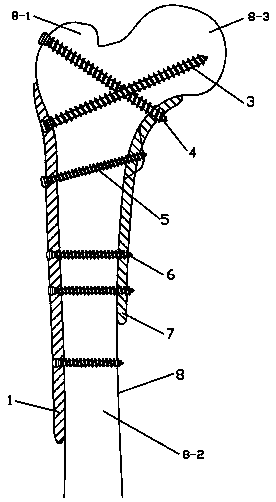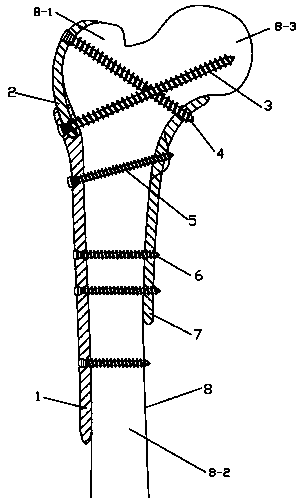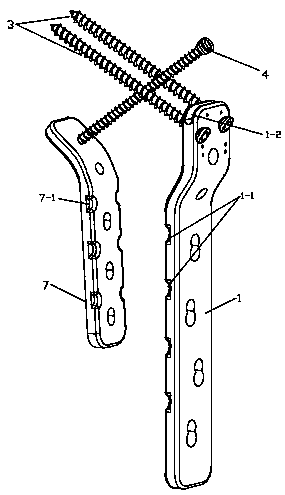Combined splint internal fixation device for femoral intertrochanteric fracture and auxiliary aiming apparatus
A technology of femoral tuberosity and fixation device, applied in the direction of internal fixator, fixator, internal bone synthesis, etc., can solve the problems of large bone damage, prolonged recovery time, and insufficient fixation, and achieves strong anti-rotation ability and design The effect of simple structure and simplified reset requirements
- Summary
- Abstract
- Description
- Claims
- Application Information
AI Technical Summary
Problems solved by technology
Method used
Image
Examples
Embodiment 1
[0014] Embodiment 1: as attached figure 1 As shown, a combined splint internal fixation device for intertrochanteric fractures, including a lateral bone plate 1, a medial talar bone plate 7, a main locking screw 3, a support screw 5, a greater trochanter screw 4, and a distal fixation screw 6. Bone plate 1 is below the greater trochanter 8-1 of the femur and is in close contact with the lateral cortex of the proximal end of the femur 8-2. A set of distal fixation screw holes and a set of inclined main locking holes and support screw holes are distributed on the outer bone plate 1 , the main locking screw 3, the supporting screw 5 and the distal fixing screw 6 are threadedly connected to the corresponding screw holes on the outer bone plate, the greater trochanter screw 4 passes through the greater trochanter 8-1 of the femur, and the inner The calcar bone plate 7 is below the femoral head 8-3 and is in close contact with the medial cortex of the proximal end of the femur 8-2. ...
Embodiment 2
[0015] Embodiment 2: see attached figure 2 , compared with Example 1, there are more trochanter reconstruction locking hook plates 2, a set of screw holes are provided on the greater trochanter reconstruction locking hook plate 2, and the greater trochanter reconstruction locking hook plate 2 covers the greater trochanter 8-1 , the upper end of the lateral bone plate 1 is provided with a groove 1-2, the lower end of the greater trochanter reconstruction locking hook plate 2 is embedded in the groove 1-2 of the lateral bone plate 1, the rear end of the main locking screw 3 is connected to the lateral bone plate 1 is threadedly connected with the greater trochanter reconstruction locking hook plate 2, and the rear end of the greater trochanter screw 4 is threaded with the greater trochanter reconstruction locking hook plate 2. The greater trochanter reconstruction locking hook plate 2 is an optional component, and whether to use it is decided according to the actual fracture co...
Embodiment 3
[0020] See attached Figure 4 , an auxiliary aiming instrument, comprising an aiming arm 9-1, a lateral bone plate clamping claw 9-3, a medial talar bone plate clamping claw 9-4, a connecting arm 9-2, a lateral bone plate top wire 9-5 and The top wire of the medial calcar bone plate, the lateral bone plate clamping claw 9-3 is fixedly connected with the aiming arm 9-1, and one end of the connecting arm 9-2 is fixed with the medial calcar bone plate clamping claw 9-4 connection, the other end of the connecting arm 9-2 is fixedly connected to the aiming arm 9-1 through a bolt 9-6, and the position of the outer bone plate clamping claw 9-3 corresponds to the position of the medial bone plate clamping claw 9-4 , the outer bone plate top wire 9-5 is threadedly connected with the aiming arm 9-1, and the medial bone plate top wire is threadedly connected with the connecting arm 9-2.
[0021] The clamping claw 9-3 of the lateral bone plate and the clamping claw 9-4 of the medial calc...
PUM
 Login to View More
Login to View More Abstract
Description
Claims
Application Information
 Login to View More
Login to View More - R&D Engineer
- R&D Manager
- IP Professional
- Industry Leading Data Capabilities
- Powerful AI technology
- Patent DNA Extraction
Browse by: Latest US Patents, China's latest patents, Technical Efficacy Thesaurus, Application Domain, Technology Topic, Popular Technical Reports.
© 2024 PatSnap. All rights reserved.Legal|Privacy policy|Modern Slavery Act Transparency Statement|Sitemap|About US| Contact US: help@patsnap.com










